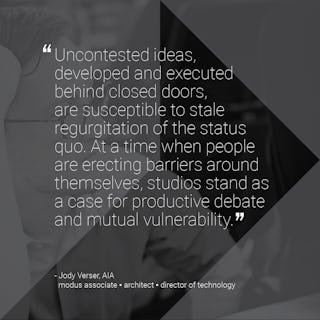modus principle #1 | studio.
Mar 28, 2021

guiding principle #1:
studio
a transparent culture of exploration.
Curating an environment where design is open, collaborative, inclusive, and inviting. Our space elevates good ideas.
...
As designers of physical spaces, we are constantly studying how the built environment affects the way in which people live, work, and play. Just as the needs of a grocery store differ from those of a library, a studio has a set of criteria that vary significantly from a law office. Studios, places for specialized or artistic exploration, thrive on open communication, controlled light, and visual connectivity. Design that can elevate the human experience is the product of reflecting upon work then improving -- never ending, always iterating. This process and its artifacts are tempered in the naked pursuit of novel ideas; spaces that foster this pursuit and its subsequent, rigorous scrutiny are vital to good design.
Studios should drive interaction with peers, by chance or purpose, exposing tenants to each other's work and ideas. Uncontested ideas, developed and executed behind closed doors, are susceptible to stale regurgitation of the status quo. At a time when people are erecting barriers around themselves, studios stand as a case for productive debate and mutual vulnerability. Additionally, a studio should balance the need for refining design through both argument and reflection. While headphones can go a long way to flip the switch between the two, they’re no substitute for a nearby, pocket park or huddle pod.

The heart of a studio is in its openness. While they might be better known for their physical openness, colleagues just seconds away from each other's feedback, they are also organized around a more abstract openness to information, ideas, and tools. Structured access to these resources is key to navigating the demands of the explorative and productive phases of design. These resources include the digital (i.e. design software, project data, research texts, internet) and the physical (i.e. graphite, angle grinders, paper, bass wood, exacto blades, material samples). This open access to talent and resources, filtered through the practice of architecture, not only helps keep the design process adaptable, but also mitigates the impulse to arrest the design process through assumption and overspecialization. A studio isn’t so much a machine for design as it is a laboratory.
A new perspective of our workplace, our studio, has accelerated into focus this year. The physical aspects of a studio environment have largely been absent from our new, remote day-to-day. Working from home, some have dedicated offices, but most do their best to find the cleanest room to post up for meetings on camera. Our large desks, with powerful design tools in-reach, aren’t available to us at home. Brief and almost unspoken communication, innate to the studio, must now be deciphered from our emails, text chats, and garbled video calls -- explicit and frequent. It’s in this new phase of working with our colleagues remotely that all the benefits of working so closely together become painfully clear. It’s easy to see the benefits to efficiency and productivity from collaboration under one roof, but perhaps even more vital, is that palpable spark that manifests in fast-paced charrettes, in-person, in-studio.
Jody Verser, AIA
associate architect | modus studio